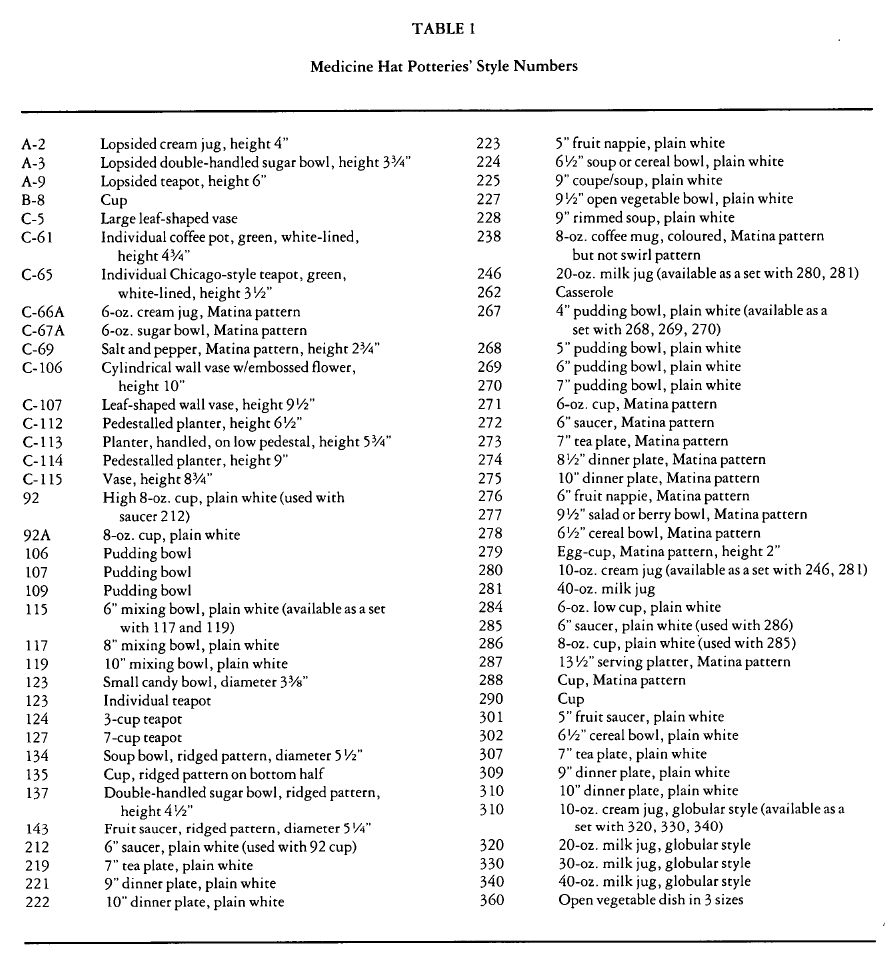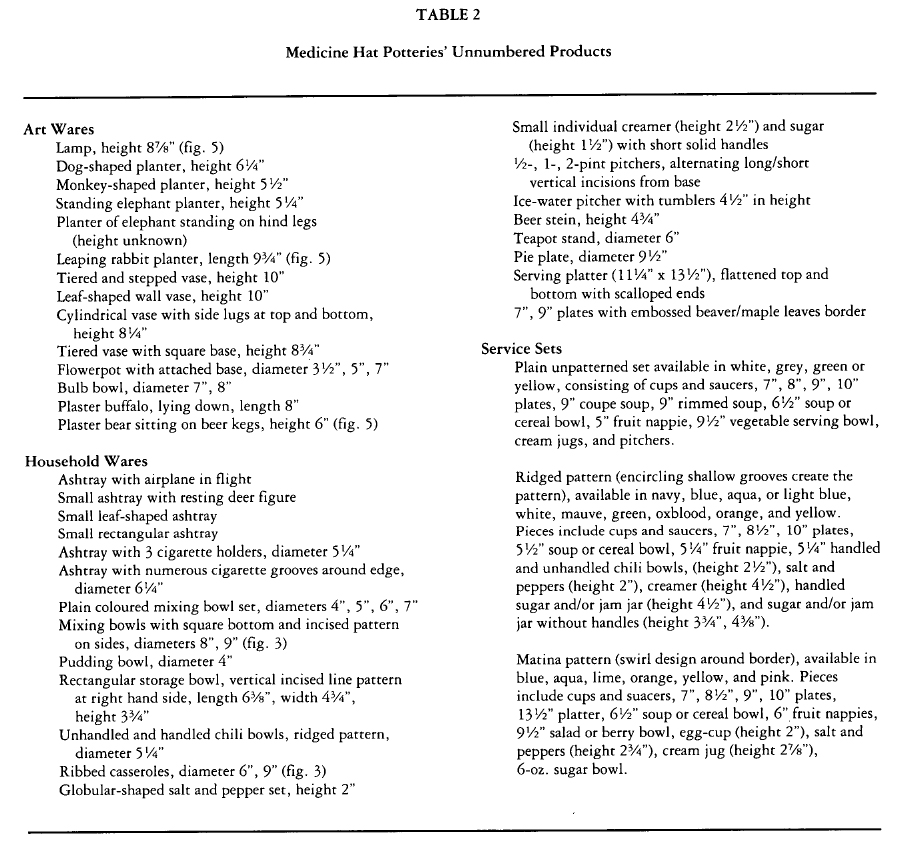Articles
The Medicine Hat and the Alberta Potteries
Abstract
Over the last ten years considerable attention has been given to the Medalta Potteries of Medicine Hat, Alberta. This paper examines the competition - the Medicine Hat Potteries of Medicine Hat and the Alberta Potteries of Redcliff, Alberta. The names of both potteries were reused and therefore we are actually looking at four separate companies.
Although research is ongoing, enough information has been gleaned to differentiate the products made by each company through trademarks. This paper illustrates these trademarks and lists the products of each company, but further research is required to determine their full complement of wares and to define the time periods when each trademark was in use.
Résumé
Depuis dix ans, les poteries Medalta de Medicine Hat (Alberta) suscitent un intérêt considérble. L'article qui suit étudie la concurrence entre la Medicine Hat Potteries de Medicine Hat et l'Alberta Potteries de Redcliff (Alberta). Les deux raisons sociales ayant été réutilisées, nous avons affaire non pas à deux, mais à quatre compagnies différentes.
Bien que les recherches se poursuivent toujours, nous avons recueilli assez d'information pour différencier les produits de chaque compagnie par les diverses estampilles de commerce employées. L'article donne des exemples de ces estampilles et énumère les produits de chaque compagnie, mais il faudra des recherches plus approfondies pour répertorier l'ensemble de leur production et définir la durée d'utilisation de chaque estampille de commerce.
Medicine Hat Pottery Company Limited, Medicine Hat, 1912-14
The Medicine Hat Pottery Company Limited was the first pottery factory in the Medicine Hat area. The Western Porcelain Manufacturing Company of Spokane established the plant in 1912 through their representative, John A. McIntyre, and by 1913 the pottery was open for business. William Clark, an experienced potter was brought from Zanesville, Ohio, as superintendent of the new plant, and with a labour force of fifty it was soon producing a variety of stonewares in its two thirty-foot, round down-draft kilns. By 1914, however, the pottery had closed its doors. Perhaps the main reason for the failure was the lack of a nearby source of clay. The pottery had to import its stoneware clay from the state of Washington, since the beds at Eastend, Saskatchewan, were not yet developed. Little is known about the range of products manufactured by this short-lived enterprise or how they were marked. One advertisement illustrates a combinette or slop jar, a shouldered jug, a teapot, and two styles of pitchers. The only marked piece that has been recorded is a three-gallon crock bearing an oval-shaped trademark containing the company's name (fig. 1). The bottom half of this American wine measure crock was plain while the top half had a dark brown glaze. The size was marked with a large impressed numeral above the trademark. A three-gallon ice-water cooler bearing the name Medicine Hat Potteries and a scene of a polar bear on ice floes has been photographed, but whether this product was made by this company or the later one is not certain (fig. 2). Following liquidation of the Medicine Hat Pottery Company, the plant was taken over by a local group which incorporated in 1915 under the name of Medalta Stone-ware Limited. By 1916 the pant was in operation again. It seems reasonable to assume that the group also acquired the moulds of the original plant, and some of Medalta Stoneware's early products may indicate what the first plant had produced. If so, we may find butter churns and ice-water coolers bearing the trademark of the Medicine Hat Pottery Company.Medicine Hat Potteries, Medicine Hat, 1938-44
Another company that is sometimes confused with the Medicine Hat Pottery Company Limited was established by the Yuill family of Medicine Hat in 1937. They believed that there was a lucrative market awaiting the production of dinnerwares, and by 1938 they had enticed enough employees away from Medalta to open their plant. The Medicine Hat Potteries was established as a division of its parent plant. Alberta Clay Products Company Limited, and for the lifetime of the company was the only serious competition that Medalta ever had. The new plant with its modern facilities, streamlined operation, and new circular tunnel kilns was still battling the established Medalta name. Despite its best efforts it could never quite capture enough of Medalta's markets to put the latter out of business. Finally, in 1956, the Yuill family sold both Alberta Clay Products and Medicine Hat Potteries to Marwell Construction of Vancouver, who manufactured and marketed products under the name Hycroft.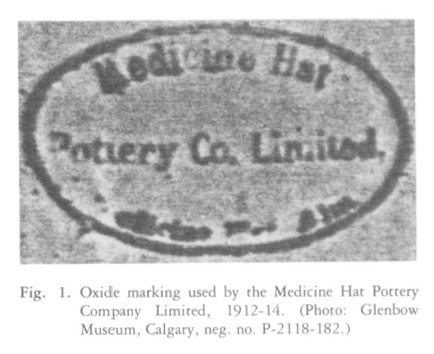 Display large image of Figure 1
Display large image of Figure 1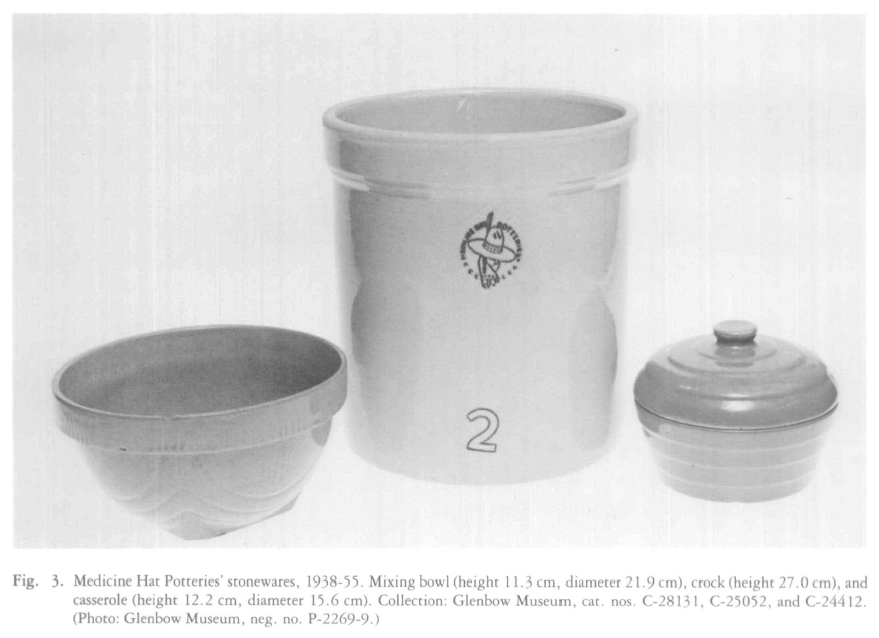 Display large image of Figure 2
Display large image of Figure 2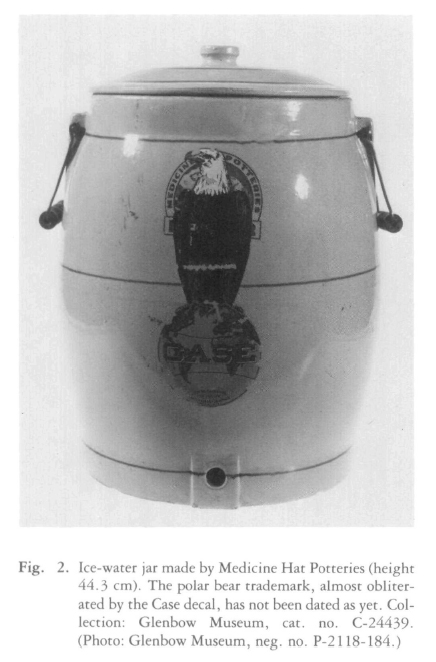 Display large image of Figure 3
Display large image of Figure 3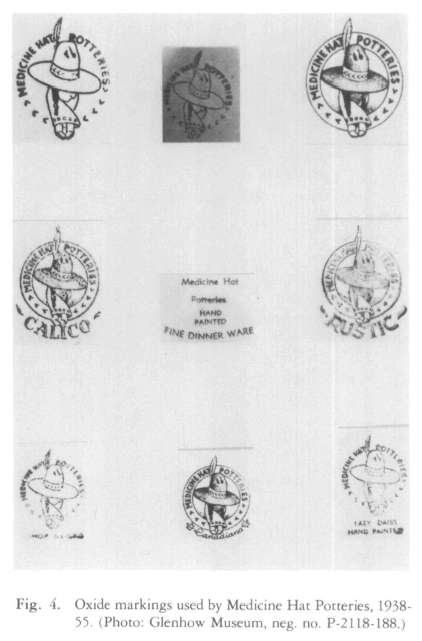 Display large image of Figure 4
Display large image of Figure 4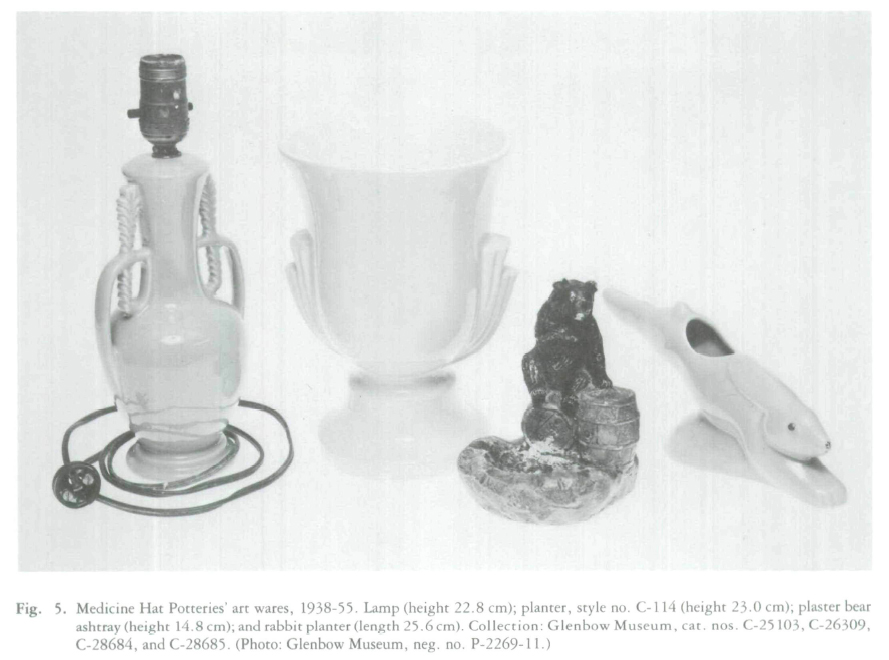 Display large image of Figure 5
Display large image of Figure 5Alberta Potteries Limited, Redcliff, 1932-38 (J.W. Wyatt)
Alberta Potteries Limited was established by Jesse William Wyatt in a remodelled automobile factory in Redcliff, Alberta. Wyatt was brought to Medicine Hat in 1924 by Medalta's management who wanted an experienced potter to act as plant supervisor. He remained with Medalta until 1929, when he left to set up his own operation in Redcliff. With his family, friends, and some former Medalta employees, he built a round down-draft kiln. A second kiln was added, but this expansion could not keep the company solvent. The Depression was forcing many western Canadian businesses to fold, and all the potteries were feeling the effects of the slump. Alberta Potteries was never any serious competition for Medalta Pottery. The staff never numbered more than fifteen, and production was anything but steady. By 1936 the company was in financial trouble, and Wyatt left for Ontario. In 1938 the plant closed its doors. During the short time it was in operation, the pottery produced wares similar to Medalta's, although they never had Medalta's variety or range of sizes. The stonewares included imperial measure crocks with a prominent beaver trademark (fig. 6) and ranging from one to ten gallons in size, butter churns, and butter crocks. At least five styles of bowls were available: two patterns were unnamed, the others were "Service," "Rex," and "Elite" (fig. 7). They produced pudding bowls, meat pie pans, casseroles, custard cups, various sizes of bean pots, two sizes of barrel-shaped cookie jars, at least four different styles of pitchers, and even a spittoon.Alberta Potteries also produced art wares. Two styles of vases have been recorded, one marked "No 1" and the other "No 50." They may have been part of a consecutive series, with another forty-eight styles still to be found. The pottery also produced a low jardinière, a bulb bowl with lugged legs, and a variety of personalized pieces, which may or may not have been production lines. The latter include two vases and a footed-bowl for holding candy or nuts. All were incised with Wyatt's initials "J.W.W." in script (fig. 6). Other items include sets of book-ends, one in the shape of a horse's head and the other an Indian wearing a feathered head-dress. The company also produced advertising, commemorative, and specialty products. These include an ashtray for the Dominion Hotel, Calgary, a mixing bowl for J.C. Falconer, dated 1933, and a cup given to school children to mark King George V and Queen Mary's jubilee in 1935.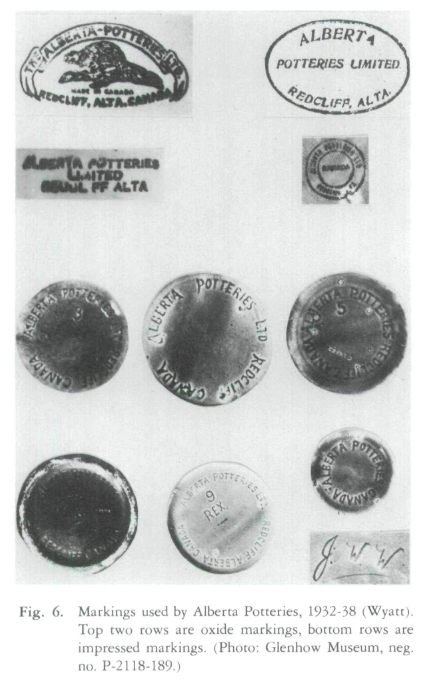 Display large image of Figure 6
Display large image of Figure 6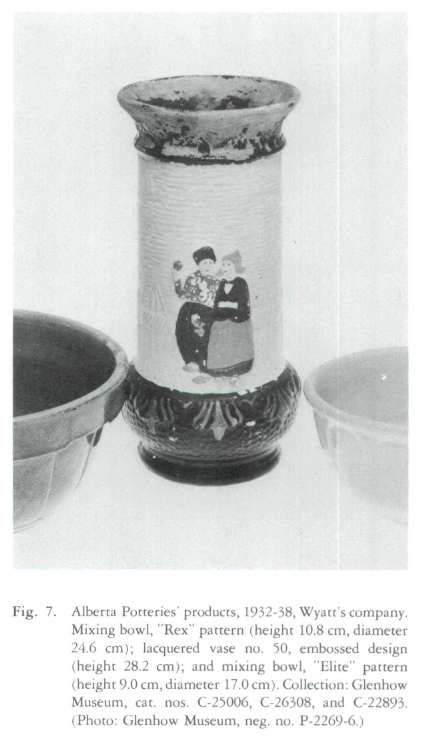 Display large image of Figure 7
Display large image of Figure 7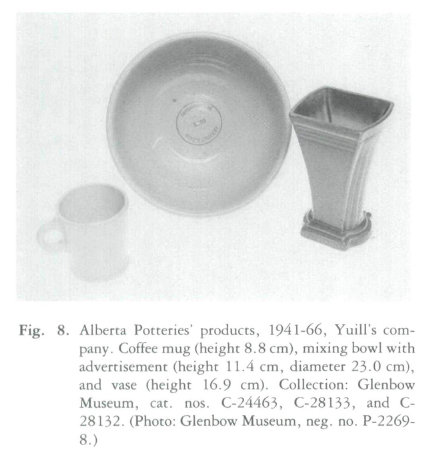 Display large image of Figure 8
Display large image of Figure 8Alberta Potteries, Redcliff, 1941-66 (J. Harlan (Hop) Yuill)
Following the closure of the Alberta Potteries Limited plant in 1938, the factory was idle until J. Harlan Yuill acquired it in 1941. The plant may have been used intermittently between 1938 and 1941, but I know of no products produced under the name of Alberta Potteries during this time. The Yuill family's Medicine Hat Potteries was equipped to produce hotel wares, and Hop Yuill was quick to realize that there was a market for inexpensive, sturdy mixing bowls. In partnership with Mr. Clark, he acquired the Alberta Potteries and, under the management of Luke Lindoe, produced a line of bowls finished with a red lead glaze. Lindoe was anxious to see the potteries expand, and when Yuill refused to do so Lindoe left. New lines were introduced and production continued to 1966 when the plant was leased to Shorty Matuska. He produced items under the name Medalta Potteries (1966) Limited. Wares produced during Yuill's time were more limited than line produced by Wyatt. Yuill's products included various sizes of crocks, bean pots, a mixing bowl, a pudding bowl, a salad bowl, an ashtray, a rabbit-shaped planter, two styles of jardinières, two styles of vases, an umbrella stand, and a number of coloured dishes, such as a soup bowl and a coffee mug (fig. 8). Antonelli and Forbes report that coloured dishes were made during Wyatt's time, but those that have been seen are of a later date. Markings on these products are illustrated in figure 9. The production line that is well dated is that of Malcolm MacArthur, who was at the Medicine Hat Potteries until 1956 when he left to manage Yuill's Alberta Potteries. During MacArthur's time at Medicine Hat Potteries he developed a set of barbecue dishes which had plates and saucers like a sectioned log (fig. 10), while the cups resembled a chopped log with a branch for a handle (fig. 11). He left Alberta Potteries in 1958 to set up his own venture in the leased Medalta Potteries plant, and again the barbecue set was produced, this time under the name of "New Medalta Ceramics." When the Medalta plant burned on 24 September 1958, MacArthur's involvement in the business ended, but a year or two later Ralph Thrall of Lethbridge had acquired and rebuilt Medalta's facilities. MacArthur became the manager of the new plant and started producing items under the name of "Sunburst Ceramics." Again the bark-pattern barbecue set became a production item.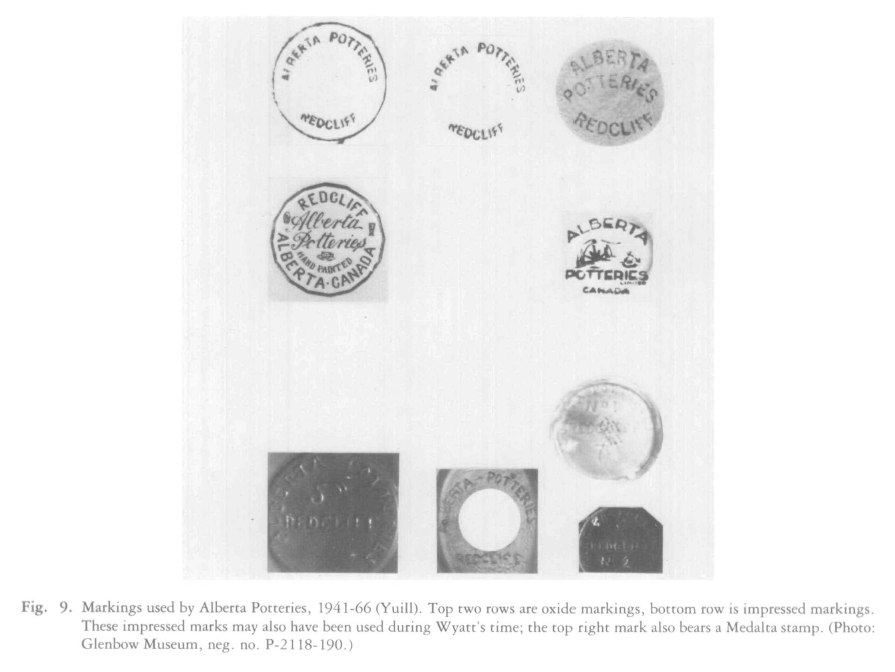 Display large image of Figure 9
Display large image of Figure 9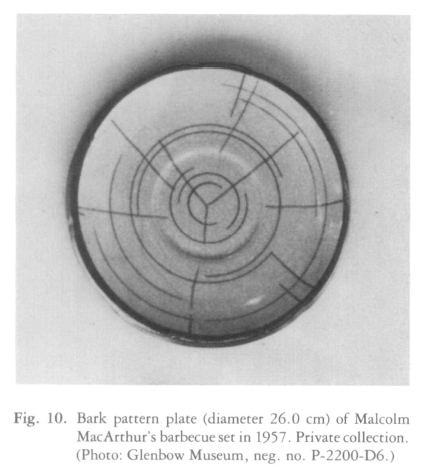 Display large image of Figure 10
Display large image of Figure 10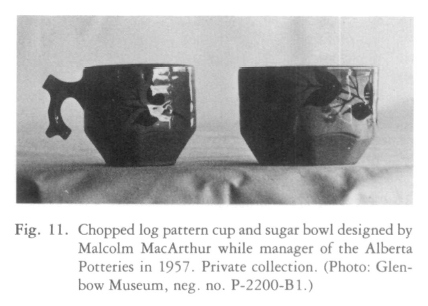 Display large image of Figure 11
Display large image of Figure 11